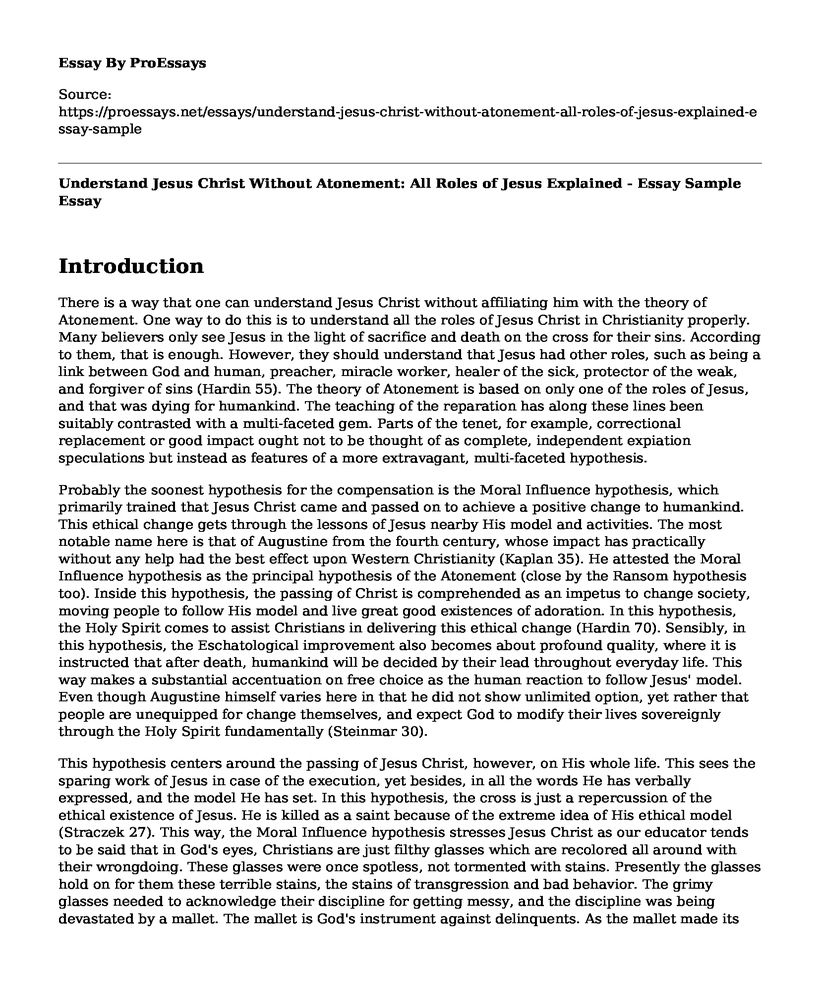Introduction
There is a way that one can understand Jesus Christ without affiliating him with the theory of Atonement. One way to do this is to understand all the roles of Jesus Christ in Christianity properly. Many believers only see Jesus in the light of sacrifice and death on the cross for their sins. According to them, that is enough. However, they should understand that Jesus had other roles, such as being a link between God and human, preacher, miracle worker, healer of the sick, protector of the weak, and forgiver of sins (Hardin 55). The theory of Atonement is based on only one of the roles of Jesus, and that was dying for humankind. The teaching of the reparation has along these lines been suitably contrasted with a multi-faceted gem. Parts of the tenet, for example, correctional replacement or good impact ought not to be thought of as complete, independent expiation speculations but instead as features of a more extravagant, multi-faceted hypothesis.
Probably the soonest hypothesis for the compensation is the Moral Influence hypothesis, which primarily trained that Jesus Christ came and passed on to achieve a positive change to humankind. This ethical change gets through the lessons of Jesus nearby His model and activities. The most notable name here is that of Augustine from the fourth century, whose impact has practically without any help had the best effect upon Western Christianity (Kaplan 35). He attested the Moral Influence hypothesis as the principal hypothesis of the Atonement (close by the Ransom hypothesis too). Inside this hypothesis, the passing of Christ is comprehended as an impetus to change society, moving people to follow His model and live great good existences of adoration. In this hypothesis, the Holy Spirit comes to assist Christians in delivering this ethical change (Hardin 70). Sensibly, in this hypothesis, the Eschatological improvement also becomes about profound quality, where it is instructed that after death, humankind will be decided by their lead throughout everyday life. This way makes a substantial accentuation on free choice as the human reaction to follow Jesus' model. Even though Augustine himself varies here in that he did not show unlimited option, yet rather that people are unequipped for change themselves, and expect God to modify their lives sovereignly through the Holy Spirit fundamentally (Steinmar 30).
This hypothesis centers around the passing of Jesus Christ, however, on His whole life. This sees the sparing work of Jesus in case of the execution, yet besides, in all the words He has verbally expressed, and the model He has set. In this hypothesis, the cross is just a repercussion of the ethical existence of Jesus. He is killed as a saint because of the extreme idea of His ethical model (Straczek 27). This way, the Moral Influence hypothesis stresses Jesus Christ as our educator tends to be said that in God's eyes, Christians are just filthy glasses which are recolored all around with their wrongdoing. These glasses were once spotless, not tormented with stains. Presently the glasses hold on for them these terrible stains, the stains of transgression and bad behavior. The grimy glasses needed to acknowledge their discipline for getting messy, and the discipline was being devastated by a mallet. The mallet is God's instrument against delinquents. As the mallet made its fair on the glass, a dish secured the glass and took the blow of the sledge to spare the glass. This skillet speaks to Jesus since Jesus yielded himself to God with the goal that God would pardon us for our transgressions. Penance is the activity of putting things directly among God and us.
Jesus, as an educator advises us to be acceptable, tail him, and live moral lives. In this model, Jesus is sparing us from our numbness since we do not know directly from wrong. He needs us to change our coldblooded conduct by him instructing and moving every one of us through his lessons and instances of adoration and information. Jesus is the scaffold among God and us that covers obliviousness and indifference. By him covering that, we change and learn, we live the moral lives he needs us to live, and we instruct and share with our kindred Christians. Jesus, as the victor, gives us how he liberates humankind from malevolence and passing. We as people are trapped in Satan's snare of underhanded and live in dread of death and devastation.
References
Cowdell, S., Fleming, C., & Hodge, J. (Eds.). (2012). Violence, Desire, and the Sacred: Girard's Mimetic Theory Across the Disciplines (Vol. 1). A&C Black.
Hardin, M. (2017). Mimetic Theory and Biblical Interpretation: Reclaiming the Good News of the Gospel. Wipf and Stock Publishers.
Kaplan, G. (2016). Rene Girard, Unlikely apologist: Mimetic theory and fundamental theology. University of Notre Dame Pess.
Steinmair-Posel, P. (2017). Original Sin, Positive Mimesis. In The Palgrave Handbook of Mimetic Theory and Religion (pp. 185-192). Palgrave Macmillan, New York.
Straczek, B. (2014). Rene Girard's concept of mimetic desire, scapegoat mechanism and biblical demystification. Seminare. Poszukiwania naukowe, 35(4), 47-56.
Cite this page
Understand Jesus Christ Without Atonement: All Roles of Jesus Explained - Essay Sample. (2023, Jun 20). Retrieved from https://proessays.net/essays/understand-jesus-christ-without-atonement-all-roles-of-jesus-explained-essay-sample
If you are the original author of this essay and no longer wish to have it published on the ProEssays website, please click below to request its removal:
- Auditing a Website for Culture Diversity: Walmart
- Essay Sample on Gay Family
- The Diversity of Teachers Annotated Bibliography Paper Example
- Dana in Buddhism Essay
- Essay Example on Deborah Saves Israel: The Story of Ehud's Passing
- Culture: Embracing Unique Identities for Social Bonding - Research Paper Sample
- Improving an Educational Institute - Report Example







